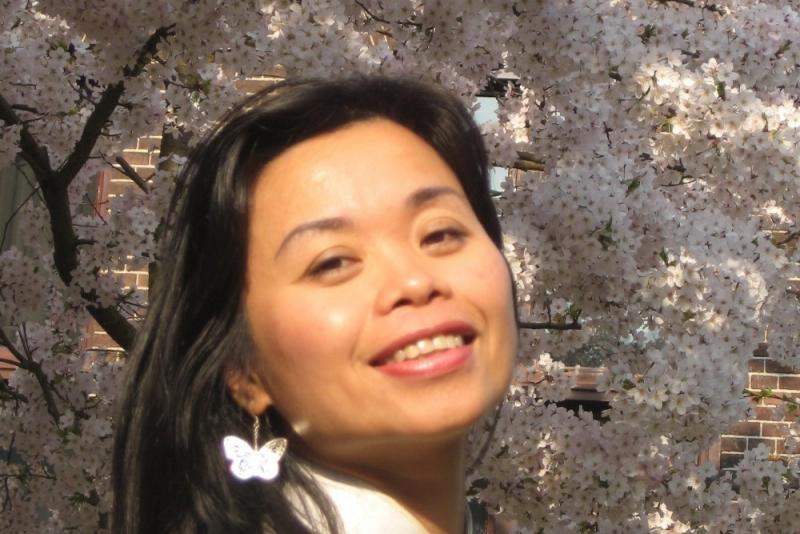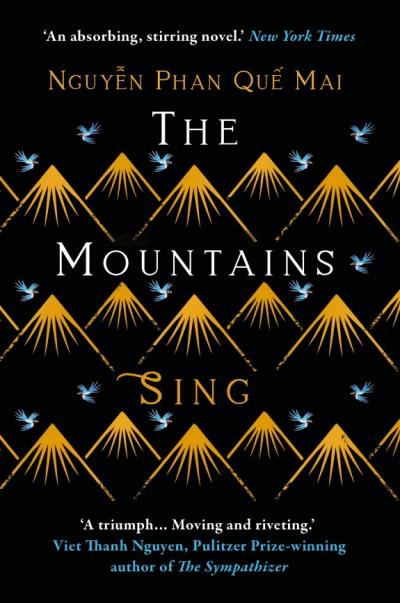Nguyễn Phan Quế Mai: The Mountains Sing review - a lyrical account of Việt Nam’s brutal past | reviews, news & interviews
Nguyễn Phan Quế Mai: The Mountains Sing review - a lyrical account of Việt Nam’s brutal past
Nguyễn Phan Quế Mai: The Mountains Sing review - a lyrical account of Việt Nam’s brutal past
A family in conflict learns to forgive and forget

“The challenges of the Vietnamese people throughout history are as tall as the tallest mountains. If you stand too close, you won’t be able to see their peaks. Once you step away from the currents of life, you will have the full view…” This is the advice a grandmother offers to her beloved granddaughter in Nguyễn Phan Quế Mai’s lyrical family saga.
The novel is narrated from the dual perspectives of Hương, affectionately known as Guava, and her grandmother, Trần Diệu Lan. In 1972, Hương and Diệu Lan are trying to survive the American bombing of Hà Nội. Hương’s parents are away fighting and she is cared for by her grandmother. After their house is reduced to rubble, they are forced to live by their wits in a makeshift shack. Diệu Lan begins to tell Guava about her childhood, the Japanese occupation in the 1940s and the ensuing famine, followed by the disastrous land reform of the 1950s.
When the communists annexe their farm, Diệu Lan’s brother and son are lynched by resentful Vietnamese neighbours. Diệu Lan becomes a pariah overnight, her home is overrun and she flees her village with five of her six children. Diệu Lan heads for Hà Nội hoping her childhood teacher will give her family shelter. A refugee in her own country she survives by eating grass, begging and the kindness of strangers.
Nguyễn spares us none of the unremittingly bleak circumstances that lead to Diệu Lan’s penury. Her novel’s structure inevitably decreases narrative tension – we know that Diệu Lan survives the tragedies life throws at her. However, Nguyễn makes up for this with her atmospheric settings: “We sat on a stone bench, under an ancient tree with its many branches reaching down to the lake’s surface, yellowing leaves flitting in the wind … in the midst of the water, the Turtle tower glimmered in the afternoon light, moss greening its walls. Atop the tower, figures of dragons and phoenixes soared up to the sky.” Her novel teems with colourful characters, and spirits with evocative names such as the Water Devil and Wicked Ghost (the money collector). Nguyễn clearly delights in her native language – two sons’ names are Thịnh and Vượng (which, together, mean prosperity).
 In Hà Nội, Diệu Lan rebuilds her life from scratch, trains as a teacher and enjoys a brief respite until conflict tears her family apart again. During the final years of the Việt Nam war, Diệu Lan, determined to shield her beloved granddaughter from destitution, becomes an illegal trader; an act vilified by their neighbours. Hương is shunned by her classmates and finds solace in the banned foreign books her grandmother procures for her. She is surprised to be able to identify with Laura Ingalls in Little House in the Big Woods: “I sat listening to her father’s music and stories. Just like my father, Pa was funny and enjoyed working with his hands. Just like my mother, Ma was attentive and lived to cook.” Books allow her to empathise with the ‘enemy’ and help her to appreciate life’s simple pleasures: the sacredness of “a normal day where we could just cook, eat, talk and laugh.”
In Hà Nội, Diệu Lan rebuilds her life from scratch, trains as a teacher and enjoys a brief respite until conflict tears her family apart again. During the final years of the Việt Nam war, Diệu Lan, determined to shield her beloved granddaughter from destitution, becomes an illegal trader; an act vilified by their neighbours. Hương is shunned by her classmates and finds solace in the banned foreign books her grandmother procures for her. She is surprised to be able to identify with Laura Ingalls in Little House in the Big Woods: “I sat listening to her father’s music and stories. Just like my father, Pa was funny and enjoyed working with his hands. Just like my mother, Ma was attentive and lived to cook.” Books allow her to empathise with the ‘enemy’ and help her to appreciate life’s simple pleasures: the sacredness of “a normal day where we could just cook, eat, talk and laugh.”
Books, proverbs and poetry teach Hương compassion and strengthen her resolve to become a poet while her grandmother learns “Young people can’t be blamed for what their ancestors did.” Following reunification, the family’s opposing political affiliations threaten a fragile equilibrium, reminding us that there are few outright winners in a country at war with itself – the important thing is to find common ground. The Mountains Sing is a moral tale with the poetic grandeur and violence of a Greek tragedy – although the brutality in Nguyễn account is experienced first-hand rather than offstage.
A powerful motif in the novel is that of the song bird. During the war, Hương’s father carves her an exquisite wooden bird and gives it to her uncle for safe keeping: Its name, Sơn ca, means “the mountain sings”. When the bird opens its throat the mountains appear to sing as well. It becomes a poetic symbol of hope: “the Sơn ca’s songs can reach Heaven, and souls of the dead can return in the Sơn ca’s singing.” Hương discovers that words pave the way to personal happiness and, like the bird, her own songs carry the promise of peace and renewal.
- The Mountains Sing by Nguyễn Phan Quế Mai (Oneworld £14.99)
- Read more book reviews on theartsdesk
Add comment
The future of Arts Journalism
You can stop theartsdesk.com closing!
We urgently need financing to survive. Our fundraising drive has thus far raised £49,000 but we need to reach £100,000 or we will be forced to close. Please contribute here: https://gofund.me/c3f6033d
And if you can forward this information to anyone who might assist, we’d be grateful.

Subscribe to theartsdesk.com
Thank you for continuing to read our work on theartsdesk.com. For unlimited access to every article in its entirety, including our archive of more than 15,000 pieces, we're asking for £5 per month or £40 per year. We feel it's a very good deal, and hope you do too.
To take a subscription now simply click here.
And if you're looking for that extra gift for a friend or family member, why not treat them to a theartsdesk.com gift subscription?
more Books
 'We are bowled over!' Thank you for your messages of love and support
Much-appreciated words of commendation from readers and the cultural community
'We are bowled over!' Thank you for your messages of love and support
Much-appreciated words of commendation from readers and the cultural community
 Robin Holloway: Music’s Odyssey review – lessons in composition
Broad and idiosyncratic survey of classical music is insightful but slightly indigestible
Robin Holloway: Music’s Odyssey review – lessons in composition
Broad and idiosyncratic survey of classical music is insightful but slightly indigestible
 Thomas Pynchon - Shadow Ticket review - pulp diction
Thomas Pynchon's latest (and possibly last) book is fun - for a while
Thomas Pynchon - Shadow Ticket review - pulp diction
Thomas Pynchon's latest (and possibly last) book is fun - for a while
 Justin Lewis: Into the Groove review - fun and fact-filled trip through Eighties pop
Month by month journey through a decade gives insights into ordinary people’s lives
Justin Lewis: Into the Groove review - fun and fact-filled trip through Eighties pop
Month by month journey through a decade gives insights into ordinary people’s lives
 Joanna Pocock: Greyhound review - on the road again
A writer retraces her steps to furrow a deeper path through modern America
Joanna Pocock: Greyhound review - on the road again
A writer retraces her steps to furrow a deeper path through modern America
 Mark Hussey: Mrs Dalloway - Biography of a Novel review - echoes across crises
On the centenary of the work's publication an insightful book shows its prescience
Mark Hussey: Mrs Dalloway - Biography of a Novel review - echoes across crises
On the centenary of the work's publication an insightful book shows its prescience
 Frances Wilson: Electric Spark - The Enigma of Muriel Spark review - the matter of fact
Frances Wilson employs her full artistic power to keep pace with Spark’s fantastic and fugitive life
Frances Wilson: Electric Spark - The Enigma of Muriel Spark review - the matter of fact
Frances Wilson employs her full artistic power to keep pace with Spark’s fantastic and fugitive life
 Elizabeth Alker: Everything We Do is Music review - Prokofiev goes pop
A compelling journey into a surprising musical kinship
Elizabeth Alker: Everything We Do is Music review - Prokofiev goes pop
A compelling journey into a surprising musical kinship
 Natalia Ginzburg: The City and the House review - a dying art
Dick Davis renders this analogue love-letter in polyphonic English
Natalia Ginzburg: The City and the House review - a dying art
Dick Davis renders this analogue love-letter in polyphonic English
 Tom Raworth: Cancer review - truthfulness
A 'lost' book reconfirms Raworth’s legacy as one of the great lyric poets
Tom Raworth: Cancer review - truthfulness
A 'lost' book reconfirms Raworth’s legacy as one of the great lyric poets
 Ian Leslie: John and Paul - A Love Story in Songs review - help!
Ian Leslie loses himself in amateur psychology, and fatally misreads The Beatles
Ian Leslie: John and Paul - A Love Story in Songs review - help!
Ian Leslie loses himself in amateur psychology, and fatally misreads The Beatles
 Samuel Arbesman: The Magic of Code review - the spark ages
A wide-eyed take on our digital world can’t quite dispel the dangers
Samuel Arbesman: The Magic of Code review - the spark ages
A wide-eyed take on our digital world can’t quite dispel the dangers

Comments
I'd like to hear the mountain